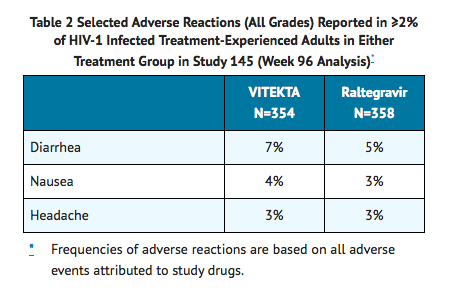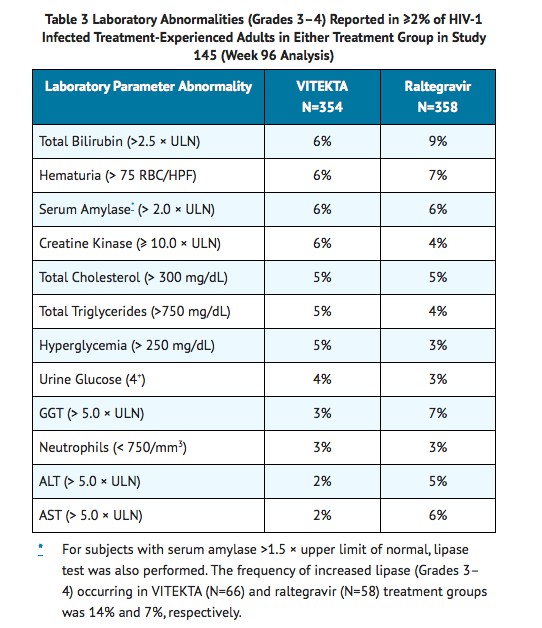Elvitegravir
Editor-In-Chief: C. Michael Gibson, M.S., M.D. [1]; Associate Editor(s)-in-Chief: Alberto Plate [2]
Disclaimer
WikiDoc MAKES NO GUARANTEE OF VALIDITY. WikiDoc is not a professional health care provider, nor is it a suitable replacement for a licensed healthcare provider. WikiDoc is intended to be an educational tool, not a tool for any form of healthcare delivery. The educational content on WikiDoc drug pages is based upon the FDA package insert, National Library of Medicine content and practice guidelines / consensus statements. WikiDoc does not promote the administration of any medication or device that is not consistent with its labeling. Please read our full disclaimer here.
Overview
Elvitegravir is {{{aOrAn}}} {{{drugClass}}} that is FDA approved for the {{{indicationType}}} of {{{indication}}}. Common adverse reactions include {{{adverseReactions}}}.
Adult Indications and Dosage
FDA-Labeled Indications and Dosage (Adult)
There is limited information regarding Elvitegravir FDA-Labeled Indications and Dosage (Adult) in the drug label.
Off-Label Use and Dosage (Adult)
Guideline-Supported Use
There is limited information regarding Off-Label Guideline-Supported Use of Elvitegravir in adult patients.
Non–Guideline-Supported Use
There is limited information regarding Off-Label Non–Guideline-Supported Use of Elvitegravir in adult patients.
Pediatric Indications and Dosage
FDA-Labeled Indications and Dosage (Pediatric)
There is limited information regarding Elvitegravir FDA-Labeled Indications and Dosage (Pediatric) in the drug label.
Off-Label Use and Dosage (Pediatric)
Guideline-Supported Use
There is limited information regarding Off-Label Guideline-Supported Use of Elvitegravir in pediatric patients.
Non–Guideline-Supported Use
There is limited information regarding Off-Label Non–Guideline-Supported Use of Elvitegravir in pediatric patients.
Contraindications
There are no contraindications to VITEKTA. Due to the need to use VITEKTA with a protease inhibitor coadministered with ritonavir, prescribers should consult the complete prescribing information of the coadministered protease inhibitor and ritonavir for a description of contraindications.
Warnings
Risk of Adverse Reactions or Loss of Virologic Response Due to Drug Interactions
The concomitant use of VITEKTA and other drugs may result in known or potentially significant drug interactions, some of which may lead to:
- Loss of therapeutic effect of VITEKTA and possible development of resistance
- Possible clinically significant adverse reactions from greater exposures of concomitant drugs or elvitegravir.
See TABLE 4 for steps to prevent or manage these possible and known significant drug interactions, including dosing recommendations. Consider the potential for drug interactions prior to and during VITEKTA therapy; review concomitant medications during VITEKTA therapy; and monitor for the adverse reactions associated with the concomitant drugs.
Use with Other Antiretroviral Agents
- Use of VITEKTA in combination with the fixed dose combination STRIBILD is not recommended, because elvitegravir is a component of STRIBILD.
- VITEKTA is indicated for use in combination with a protease inhibitor coadministered with ritonavir and with other antiretroviral drug(s). VITEKTA in combination with a protease inhibitor and cobicistat is not recommended because dosing recommendations for such combinations have not been established and may result in suboptimal plasma concentrations of VITEKTA and/or the protease inhibitor, leading to loss of therapeutic effect and development of resistance.
Immune Reconstitution Syndrome
- Immune reconstitution syndrome has been reported in patients treated with combination antiretroviral therapy. During the initial phase of combination antiretroviral treatment, patients whose immune systems respond may develop an inflammatory response to indolent or residual opportunistic infections (such as Mycobacterium avium infection, cytomegalovirus, Pneumocystis jirovecii pneumonia PCP, or tuberculosis), which may necessitate further evaluation and treatment.
- Autoimmune disorders (such as Graves' disease, polymyositis, and Guillain-Barré syndrome) have also been reported to occur in the setting of immune reconstitution syndrome; however, the time to onset is more variable, and can occur many months after initiation of treatment.
Adverse Reactions
Clinical Trials Experience
Because clinical trials are conducted under widely varying conditions, adverse reaction rates observed in the clinical trials of a drug cannot be directly compared to rates in the clinical trials of another drug and may not reflect the rates observed in practice.
The safety assessment of VITEKTA is primarily based on data from a controlled clinical trial, Study 145, in which 712 HIV-1 infected, antiretroviral treatment-experienced adults received VITEKTA (N=354) or raltegravir (N=358), each administered with a background regimen consisting of a fully active protease inhibitor coadministered with ritonavir and with other antiretroviral drug(s) for at least 96 weeks.
The proportion of subjects who discontinued study treatment due to adverse events, regardless of severity, was 3% in the VITEKTA group and 4% in the raltegravir group. The most common adverse reaction (all Grades, incidence greater than or equal to 5%) in subjects receiving VITEKTA in Study 145 was diarrhea. See also TABLE 2 for the frequency of adverse reactions occurring in at least 2% of subjects in any treatment group in Study 145.

Less Common Adverse Reactions Observed in Treatment-Experienced Studies: The following adverse reactions occurred in <2% of subjects receiving VITEKTA combined with a protease inhibitor and ritonavir. These reactions have been included because of their seriousness, increased frequency on VITEKTA compared with raltegravir, or investigator's assessment of potential causal relationship.
Gastrointestinal Disorders: abdominal pain, dyspepsia, vomiting General Disorders and Administration Site Conditions: fatigue Psychiatric Disorders: depression, insomnia, suicidal ideation and suicide attempt (<1%, most in subjects with a pre-existing history of depression or psychiatric illness) Skin and Subcutaneous Tissue Disorders: rash Laboratory Abnormalities: The frequency of laboratory abnormalities (Grades 3–4), occurring in at least 2% of subjects in either treatment group in Study 145, is presented in Table 3.
Postmarketing Experience

Drug Interactions
Effect of Concomitant Drugs on the Pharmacokinetics of Elvitegravir
Elvitegravir is metabolized by CYP3A. Drugs that induce CYP3A activity are expected to increase the clearance of elvitegravir, as well as ritonavir. This may result in decreased plasma concentrations of elvitegravir and/or a concomitantly administered protease inhibitor and lead to loss of therapeutic effect and to possible resistance.
Established and Other Potentially Significant Interactions
Table 4 provides dosing recommendations as a result of potentially clinically significant drug interactions with VITEKTA. These recommendations are based on either drug-drug interaction studies or predicted interactions due to the expected magnitude of interaction and potential for serious adverse events or loss of therapeutic effect.
For additional drug-drug interactions related to protease inhibitors coadministered with ritonavir, consult the prescribing information of the coadministered protease inhibitor and ritonavir.
The table is not all-inclusive.

Use in Specific Populations
Pregnancy
Pregnancy Category (FDA):
There is no FDA guidance on usage of Elvitegravir in women who are pregnant.
Pregnancy Category (AUS):
There is no Australian Drug Evaluation Committee (ADEC) guidance on usage of Elvitegravir in women who are pregnant.
Labor and Delivery
There is no FDA guidance on use of Elvitegravir during labor and delivery.
Nursing Mothers
There is no FDA guidance on the use of Elvitegravir in women who are nursing.
Pediatric Use
There is no FDA guidance on the use of Elvitegravir in pediatric settings.
Geriatic Use
There is no FDA guidance on the use of Elvitegravir in geriatric settings.
Gender
There is no FDA guidance on the use of Elvitegravir with respect to specific gender populations.
Race
There is no FDA guidance on the use of Elvitegravir with respect to specific racial populations.
Renal Impairment
There is no FDA guidance on the use of Elvitegravir in patients with renal impairment.
Hepatic Impairment
There is no FDA guidance on the use of Elvitegravir in patients with hepatic impairment.
Females of Reproductive Potential and Males
There is no FDA guidance on the use of Elvitegravir in women of reproductive potentials and males.
Immunocompromised Patients
There is no FDA guidance one the use of Elvitegravir in patients who are immunocompromised.
Administration and Monitoring
Administration
There is limited information regarding Elvitegravir Administration in the drug label.
Monitoring
There is limited information regarding Elvitegravir Monitoring in the drug label.
IV Compatibility
There is limited information regarding the compatibility of Elvitegravir and IV administrations.
Overdosage
There is limited information regarding Elvitegravir overdosage. If you suspect drug poisoning or overdose, please contact the National Poison Help hotline (1-800-222-1222) immediately.
Pharmacology
There is limited information regarding Elvitegravir Pharmacology in the drug label.
Mechanism of Action
There is limited information regarding Elvitegravir Mechanism of Action in the drug label.
Structure
There is limited information regarding Elvitegravir Structure in the drug label.
Pharmacodynamics
There is limited information regarding Elvitegravir Pharmacodynamics in the drug label.
Pharmacokinetics
There is limited information regarding Elvitegravir Pharmacokinetics in the drug label.
Nonclinical Toxicology
There is limited information regarding Elvitegravir Nonclinical Toxicology in the drug label.
Clinical Studies
There is limited information regarding Elvitegravir Clinical Studies in the drug label.
How Supplied
There is limited information regarding Elvitegravir How Supplied in the drug label.
Storage
There is limited information regarding Elvitegravir Storage in the drug label.
Images
Drug Images
{{#ask: Page Name::Elvitegravir |?Pill Name |?Drug Name |?Pill Ingred |?Pill Imprint |?Pill Dosage |?Pill Color |?Pill Shape |?Pill Size (mm) |?Pill Scoring |?NDC |?Drug Author |format=template |template=DrugPageImages |mainlabel=- |sort=Pill Name }}
Package and Label Display Panel
{{#ask: Label Page::Elvitegravir |?Label Name |format=template |template=DrugLabelImages |mainlabel=- |sort=Label Page }}
Patient Counseling Information
There is limited information regarding Elvitegravir Patient Counseling Information in the drug label.
Precautions with Alcohol
Alcohol-Elvitegravir interaction has not been established. Talk to your doctor about the effects of taking alcohol with this medication.
Brand Names
There is limited information regarding Elvitegravir Brand Names in the drug label.
Look-Alike Drug Names
There is limited information regarding Elvitegravir Look-Alike Drug Names in the drug label.
Drug Shortage Status
Price
References
The contents of this FDA label are provided by the National Library of Medicine.
Elvitegravir (EVG) is an investigational drug for the treatment of HIV. It acts as an integrase inhibitor. It is undergoing clinical trials conducted by the pharmaceutical company Japan Tobacco.[1][2]
According to the results of the phase II clinical trial, patients taking once-daily elvitegravir boosted by ritonavir had greater reductions in viral load after 24 weeks compared to individuals randomized to receive a ritonavir-boosted protease inhibitor.[3]
References
- ↑ Shimura K, Kodama E, Sakagami Y; et al. (2007). "Broad Anti-Retroviral Activity and Resistance Profile of a Novel Human Immunodeficiency Virus Integrase Inhibitor, Elvitegravir (JTK-303/GS-9137)". J Virol. doi:10.1128/JVI.01534-07. PMID 17977962.
- ↑ Stellbrink HJ (2007). "Antiviral drugs in the treatment of AIDS: what is in the pipeline ?". Eur. J. Med. Res. 12 (9): 483–95. PMID 17933730.
- ↑ Thaczuk, Derek and Carter, Micheal. ICAAC: Best response to elvitegravir seen when used with T-20 and other active agents Aidsmap.com. 19 Sept. 2007.